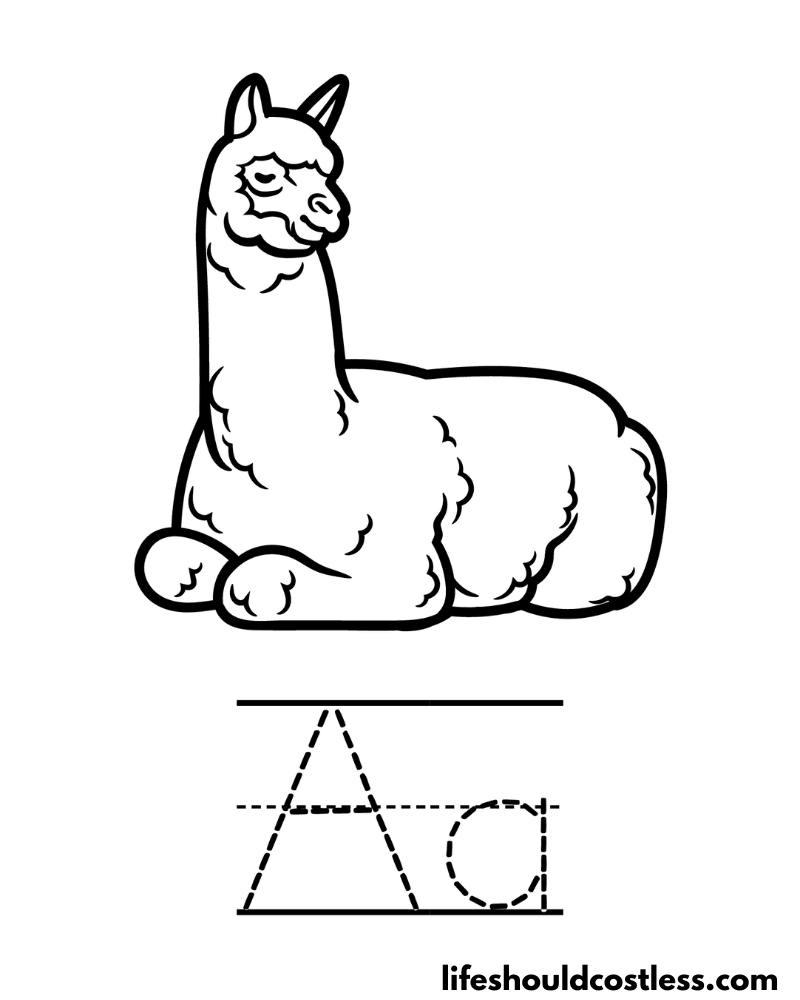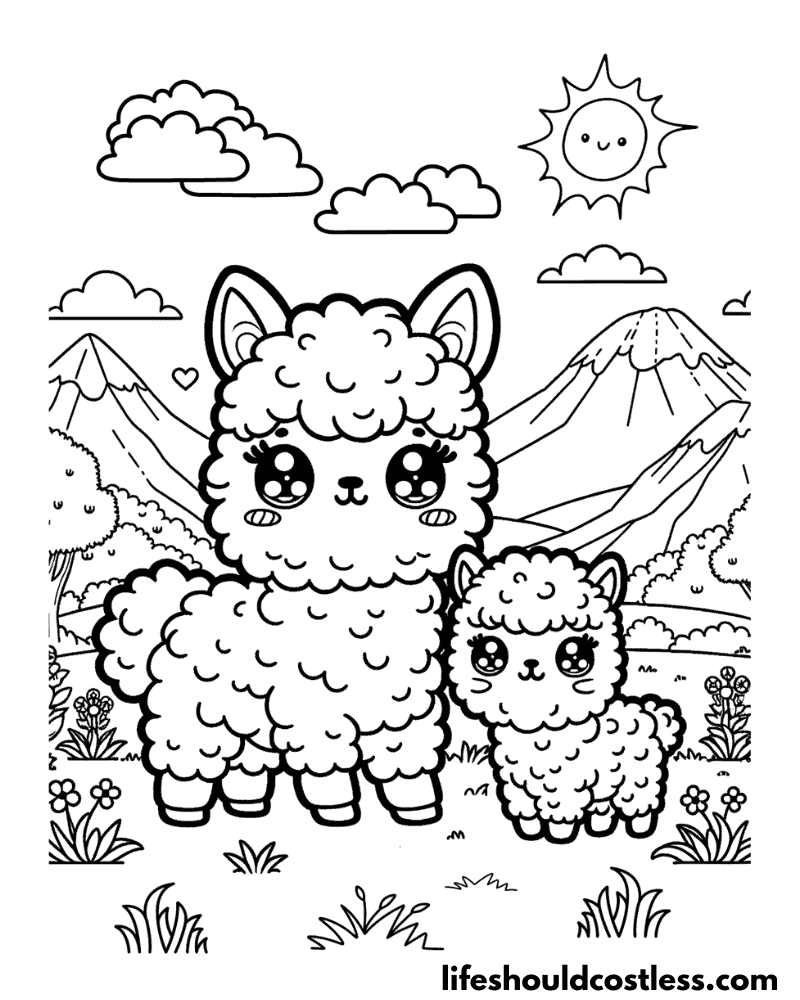Our alpaca coloring pages offer a delightful gateway into the wooly world of these gentle, fleece-bearing creatures, beloved for their soft, huggable appearances and serene demeanor. Perfect for artists and enthusiasts of all ages, these coloring pages not only provide a fun and relaxing activity but also an educational experience, inviting individuals to explore the rich variety of alpaca breeds and their distinctive coats. Whether you’re a parent looking for a creative way to engage your child, an educator incorporating art into learning about animals, or simply someone who enjoys the meditative benefits of coloring, alpaca color sheets serve as a charming invitation to unleash one’s artistic talents, celebrate the beauty of these animals, and perhaps, learn a bit more about their importance in cultures around the world.

Feel at liberty to pick any design that appeals to you.
Just select the template you like, download the free PDF, print it out, and allow your coloring creativity to flourish without limits.
Additionally, these templates can be used as guides for embroidery or as inspiration for detailed fine line tattoos.
The opportunities are as boundless as your imagination permits.
Alpaca facts
For newcomers to my coloring pages, I want to highlight that I take pleasure in offering you the chance to dive deep into the subject matter.
This approach allows you to effortlessly turn your coloring activity into a learning adventure.
With that in mind, let’s get started!
Here are several fun and interesting facts about alpacas:
- Friendly and Social Creatures: Alpacas are known for their gentle and friendly demeanor, making them excellent companions. They are highly social animals that thrive in community settings, usually seen grazing together in herds.
- Two Breeds: There are two main breeds of alpacas: the Huacaya (pronounced wah-KI-ya), which has a fluffy, wooly coat that gives it a teddy bear-like appearance, and the Suri, which has long, silky fibers that hang in beautiful locks.
- Unique Humming Communication: Alpacas communicate through a soft humming sound, which can convey curiosity, contentment, or concern, providing a fascinating insight into their emotional state.
- Native to the Andes Mountains: Originally from the Andean highlands in South America, alpacas are well-adapted to altitudes of 12,000 to 15,000 feet (3,658 to 4,572 meters) above sea level.
- Exceptional Wool: Alpaca wool is renowned for its softness, warmth, and hypoallergenic properties. Unlike sheep’s wool, it does not contain lanolin, making it less allergenic.
- Eco-Friendly Grazers: Their padded feet are gentle on the terrain, and they graze without destroying root systems, making them environmentally friendly compared to other grazing animals.
- Wide Range of Colors: Alpaca fiber comes in an impressive spectrum of natural colors, over 22 to be precise, ranging from white and light fawn to browns, grays, and even black.
- Lifespan and Size: Alpacas typically live for about 15 to 20 years and stand at about 34 to 36 inches (86 to 91 cm) at the withers, with an average weight of 150 to 200 pounds (68 to 91 kg).
- Spitting When Distressed: While generally calm and docile, alpacas can spit at each other (or occasionally at humans) when agitated, distressed, or competing for food. This is more common among themselves to establish pecking order.
- Valuable Manure: Alpaca manure, known as “black gold” among gardeners, is an excellent, nutrient-rich plant fertilizer that doesn’t need to be composted before use, unlike many other animal manures.
We’ve uncovered a great deal about alpacas, yet there’s still more to discover.
For those interested in deepening their knowledge, here are some additional trustworthy sources worth exploring:
- https://en.wikipedia.org/wiki/Alpaca
- https://nationalzoo.si.edu/animals/alpaca
- https://www.britannica.com/animal/alpaca
- https://www.agric.wa.gov.au/small-landholders-western-australia/basics-alpaca-keeping
- https://news.vanderbilt.edu/2019/08/13/meet-the-alpacas-that-could-cure-autism-alzheimers-and-cancer/
- To see all of my free printables, go here.
- If you would like to see an alphabetized index of free printable coloring pages, go here!
- All of my animals coloring pages are found here.
- Or, my other mammals coloring pages can be found here.
Coloring tips
Coloring a picture of an alpaca can offer a joyful and imaginative journey.
Below are some of my top suggestions and techniques to bring vibrancy and realism to your alpaca art piece:
- Study Alpaca Colors: Before you begin, look at pictures of alpacas to familiarize yourself with their natural colors. Alpacas come in a wide range of colors, from white and light fawn to deep browns and blacks. Using a variety of shades can add realism to your artwork.
- Layer Your Colors: Start with lighter colors and gradually build up to darker shades. This technique allows for depth and dimension in your coloring, especially in depicting the fluffy texture of the alpaca’s wool.
- Blend for Softness: Use blending tools, like blending pencils, stumps, or even your finger, to soften the transitions between colors. This mimics the soft, smooth texture of the alpaca’s fleece.
- Add Texture: Use short, curved strokes to replicate the alpaca’s woolly texture. Vary the pressure of your pencil to create the illusion of volume and fluffiness.
- Highlight the Eyes: Alpacas have expressive eyes. Pay special attention to coloring the eyes, using reflection spots to make them lively and soulful, which can bring character to your artwork.
- Use a Reference Photo: Having a reference photo can be incredibly helpful for getting the proportions right and adding realistic details, such as the positioning of the ears, the shape of the nose, and the way the fur flows.
- Incorporate Shadows and Highlights: Identify the light source in your drawing and use it to add shadows and highlights. This will give your alpaca a three-dimensional appearance. Lighter areas where the light hits directly and darker shades on the opposite side enhance realism.
- Experiment with Backgrounds: Don’t forget the background. A well-thought-out background can place your alpaca in its natural Andean highlands habitat or any imaginative setting you prefer. It adds context and depth to your artwork.
- Personalize with Patterns: Feel free to add personal touches, such as unique patterns or colors in the alpaca’s fleece. This can make your artwork stand out and reflect your creative style.
- Practice Patience: Take your time with each step, from outlining to final touches. The more patience and care you put into your coloring, the more striking your finished alpaca picture will be. Remember, it’s not about rushing to complete it but enjoying the process of bringing your alpaca to life.
I’m hoping that with these handy tips you get the most out of your coloring experience.
Options For Printing:
Letter A is for alpaca writing practice worksheets
*My letter A is for alpaca coloring sheet printables available here are crafted with classroom use in mind, making them the sole printables on this page that can be utilized in public settings without the need for written consent.
Should anyone inquire about their origin, kindly direct them to this post by sharing the link.
Thank you!



Various alpaca designs




FAQ’s
The most common colors found in alpacas are:
White
Light fawn
Medium fawn
Dark fawn
Brown
Gray
Black
*I will add more alpaca colour / color questions and answers as the questions get sent to me.
Conclusion
In conclusion, our alpaca coloring pages offer a unique and engaging opportunity for individuals of all ages to connect with these charming creatures through art.
With a palette of common alpaca colors ranging from serene whites to deep blacks, colorists can explore and celebrate the diversity of alpaca fur while indulging in a relaxing, creative activity.
Whether used as a tool for relaxation, education, or artistic expression, these coloring pages serve as a testament to the beauty and allure of alpacas, inviting everyone to delve into their world with every color they lay down.
Happy coloring!
Thanks so much for stopping by my blog and supporting my endeavors to make people’s lives a little easier/better/more affordable.
If you liked this post, or found it helpful in any way, please make sure to share it with your family, friends, and co-workers via social media.
Or you could even send them the direct link via email. Whichever way you choose to spread the love, I super appreciate it! ~Sarah

How To Follow & Support This Site
- If you would like to subscribe to my email list, go here.
- Make sure to follow along via social media, by going here.
- If you would like to learn how to really show your support to this site (at no cost to you), go here.
- If you would like to make a direct donation to the site, go here.
Check out my other free printables
- To see all of my free printables, go here.
- If you would like to see an alphabetized index of free printable coloring pages, go here!
- All of my animals coloring pages are found here.
- Or, my other mammals coloring pages can be found here.
Otherwise, here are direct links to several of my other related posts that you’re also going to love:
Animals / Mammals
Other good resources for a printable alpaca
- https://www.supercoloring.com/coloring-pages/alpaca
- https://www.coloringall.com/coloring-pages/alpaca/
- https://coloring.rocks/llama-coloring-pages/
*This post was originally shared to this blog on03/25/2024, and has since been updated to improve user experience, possibly add video instruction, as well as to make it as shareable as possible across the social medias.
**Please note that I do try my hardest to provide factual, but easy to understand, information about each topic. If you notice a discrepancy in my coloring pages, facts, or see something that you deem “misinformation/incorrect” please make sure to notify me about it. I would prefer that you send me an email with a link to a more reputable resource on that subject, so that I can correct it as soon as possible. Thanks so much for helping this site become the best that it can be!
***Resources from djinkers were used in the production of this article.
